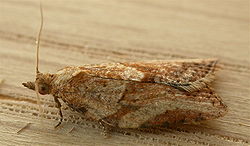- Epiphyas postvittana
-
Epiphyas postvittana
Epiphyas postvittana

Epiphyas postvittana Classification classique Règne Animalia Embranchement Arthropoda Sous-embr. Hexapoda Classe Insecta Sous-classe Pterygota Infra-classe Neoptera Super-ordre Endopterygota Ordre Lepidoptera Sous-ordre Ditrysia Super-famille Tortricoidea Famille Tortricidae Sous-famille Tortricinae Genre Epiphyas Nom binominal Epiphyas postvittana
Walker, 1863
D'autres documents multimédia
sont disponibles sur Commons Retrouvez ce taxon sur Wikispecies
Retrouvez ce taxon sur WikispeciesParcourez la biologie sur Wikipédia : Epiphyas postvittana est une pyrale (lépidoptère ; petit papillon de nuit), aussi appelé LBAM (Light Brown Apple Moth), originaire d'Australie.
Sommaire
Espèce invasive
Ce papillon autochtone en Australie a été involontairement introduit en Nouvelle-Zélande, à Hawaï et en Grande-Bretagne. Il est apparu en Californie en 2007, avec 3500 individus capturés en 6 mois, autour de Santa Cruz[1].
Sa chenille est redoutée des producteurs fruitiers et des viticulteurs, car sa larve est polyphage (elle s'attaque à environ 250 espèces de fruits et plantes, dont pommes, amandes, carottes, citrons, pêches, noix, roses, fraises et raisin). La larve est particulièrement vorace, préférant les jeunes fruits qui conservent ensuite des cicatrices en compromettant la commercialisation.
Voir aussi
Liens externes
Notes et références
- Portail de l’Australie
- Portail de la zoologie
Catégories : Espèce invasive | Lépidoptère | Tortricidé
Wikimedia Foundation. 2010.
